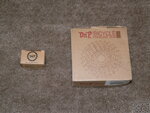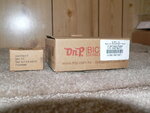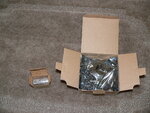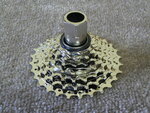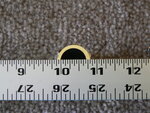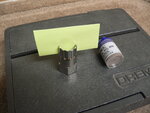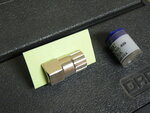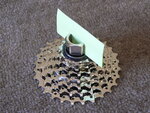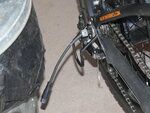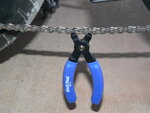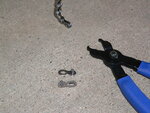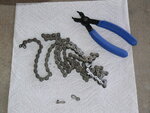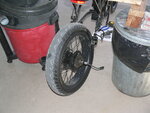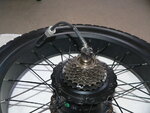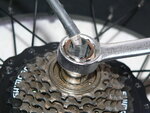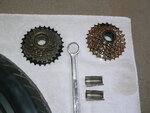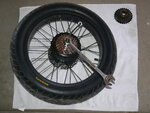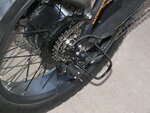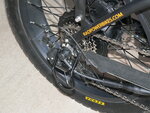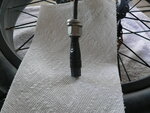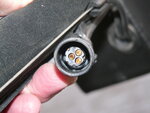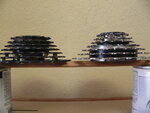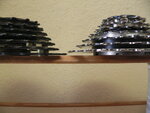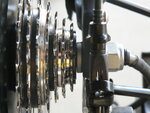cayjak
Member
New RadMini (2018 model) owner here. I find the discussion in other threads about changing gear ratios interesting, because I too would like to slow down my pedal cadence. To do this, as I understand it, you can change either the rear gears (the freewheel), or the front chainring, or both.
The stock freewheel (on my 2018 RadMini) is a Shimano MF-TZ500-7 with tooth count of 14-16-18-20-22-24-28. If you change to the DNP 11/28 freewheel (link below), which is a direct replacement, it has tooth count of 11-13-15-18-21-24-28. With the DNP, you are reducing your pedal speed in 3rd through 7th gears, but the two lowest gears (1st and 2nd) remain unchanged. Replacing the freewheel may require a special deep thin wall freewheel tool.
On the other hand, if you change the front chainring from the stock 48 tooth to a larger 53 tooth (link below), you will decrease your pedal cadence (at any given speed) in ALL 7 gears. Replacing the chainring will require replacing or lengthening the chain.
For the greatest possible degree of change, you could replace BOTH the freewheel AND the front chainring.
The question is: which option, new freewheel or new chainring, gives you the most bang for the buck?
To answer this question, we can reduce each combination to a simple number called "gear inches". To find this number you divide the number of chainring teeth by the number of teeth on the freewheel sprocket. This produces a "gear ratio" number. Then you multiply the gear ratio by the diameter of the rear wheel. This produces the "gear inch" number.
Since most of us are primarily interested in decreasing our pedal cadence in top gear, I will only do the 7th gear calculation for the the stock setup, plus the 3 possible combinations listed above. I used 22" for the wheel diameter, because that is what is set in the motor control panel on my bike.
Here are the results, listing the percent improvement over stock for each combination, in 7th gear:
( stock ) 48t chainring divided by (stock) 14t (7th gear) sprocket = 3.43 ratio times 22" wheel diameter = 75 gear inches (stock)
(bigger) 53t chainring divided by (stock) 14t (7th gear) sprocket = 3.79 ratio times 22" wheel diameter = 83 gear inches (11% better than stock)
( stock ) 48t chainring divided by (DNP ) 11t (7th gear) sprocket = 4.36 ratio times 22" wheel diameter = 96 gear inches (28% better than stock)
(bigger) 53t chainring divided by (DNP ) 11t (7th gear) sprocket = 4.82 ratio times 22" wheel diameter = 106 gear inches (41% better than stock)
Cost of modifications:
Replacing the front chainring costs about $53 (Amazon Prime) plus the cost of replacing or extending the chain, for 11% improvement.
Replacing the freewheel costs about $32 (Amazon Prime) plus the cost of a freewheel tool (use the original chain), for 28% improvement.
Replacing both the front chainring and the freewheel costs about $85 (plus cost of chain and a freewheel tool) ), for 41% improvement.
My conclusion:
If your primary objective is to slow down your cadence in the upper gears (3rd through 7th) for the least expense, then the new freewheel would seem to be the best choice. Although I only calculated the percent change in 7th gear, you would also see a improvement in gears 3 through 6. If it turns out you still want more reduction in pedal speed after trying the new freewheel, you could then replace the front chainring.
NOTE: I am just a novice at this bike gear stuff, so if I made any errors in my math, please feel free to point them out!
https://www.amazon.com/gp/product/B071LPKGT2/ref=oh_aui_detailpage_o02_s00?ie=UTF8&psc=1
https://www.amazon.com/DNP-Epoch-Freewheel-Nickel-Plated/dp/B007A8RPUS
The stock freewheel (on my 2018 RadMini) is a Shimano MF-TZ500-7 with tooth count of 14-16-18-20-22-24-28. If you change to the DNP 11/28 freewheel (link below), which is a direct replacement, it has tooth count of 11-13-15-18-21-24-28. With the DNP, you are reducing your pedal speed in 3rd through 7th gears, but the two lowest gears (1st and 2nd) remain unchanged. Replacing the freewheel may require a special deep thin wall freewheel tool.
On the other hand, if you change the front chainring from the stock 48 tooth to a larger 53 tooth (link below), you will decrease your pedal cadence (at any given speed) in ALL 7 gears. Replacing the chainring will require replacing or lengthening the chain.
For the greatest possible degree of change, you could replace BOTH the freewheel AND the front chainring.
The question is: which option, new freewheel or new chainring, gives you the most bang for the buck?
To answer this question, we can reduce each combination to a simple number called "gear inches". To find this number you divide the number of chainring teeth by the number of teeth on the freewheel sprocket. This produces a "gear ratio" number. Then you multiply the gear ratio by the diameter of the rear wheel. This produces the "gear inch" number.
Since most of us are primarily interested in decreasing our pedal cadence in top gear, I will only do the 7th gear calculation for the the stock setup, plus the 3 possible combinations listed above. I used 22" for the wheel diameter, because that is what is set in the motor control panel on my bike.
Here are the results, listing the percent improvement over stock for each combination, in 7th gear:
( stock ) 48t chainring divided by (stock) 14t (7th gear) sprocket = 3.43 ratio times 22" wheel diameter = 75 gear inches (stock)
(bigger) 53t chainring divided by (stock) 14t (7th gear) sprocket = 3.79 ratio times 22" wheel diameter = 83 gear inches (11% better than stock)
( stock ) 48t chainring divided by (DNP ) 11t (7th gear) sprocket = 4.36 ratio times 22" wheel diameter = 96 gear inches (28% better than stock)
(bigger) 53t chainring divided by (DNP ) 11t (7th gear) sprocket = 4.82 ratio times 22" wheel diameter = 106 gear inches (41% better than stock)
Cost of modifications:
Replacing the front chainring costs about $53 (Amazon Prime) plus the cost of replacing or extending the chain, for 11% improvement.
Replacing the freewheel costs about $32 (Amazon Prime) plus the cost of a freewheel tool (use the original chain), for 28% improvement.
Replacing both the front chainring and the freewheel costs about $85 (plus cost of chain and a freewheel tool) ), for 41% improvement.
My conclusion:
If your primary objective is to slow down your cadence in the upper gears (3rd through 7th) for the least expense, then the new freewheel would seem to be the best choice. Although I only calculated the percent change in 7th gear, you would also see a improvement in gears 3 through 6. If it turns out you still want more reduction in pedal speed after trying the new freewheel, you could then replace the front chainring.
NOTE: I am just a novice at this bike gear stuff, so if I made any errors in my math, please feel free to point them out!
https://www.amazon.com/gp/product/B071LPKGT2/ref=oh_aui_detailpage_o02_s00?ie=UTF8&psc=1
https://www.amazon.com/DNP-Epoch-Freewheel-Nickel-Plated/dp/B007A8RPUS
